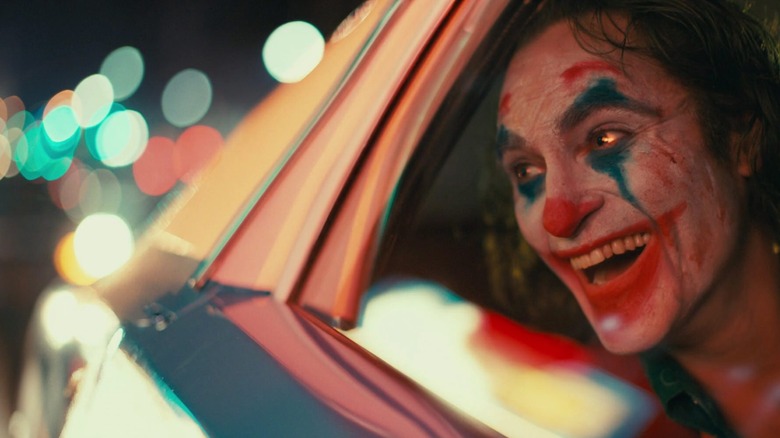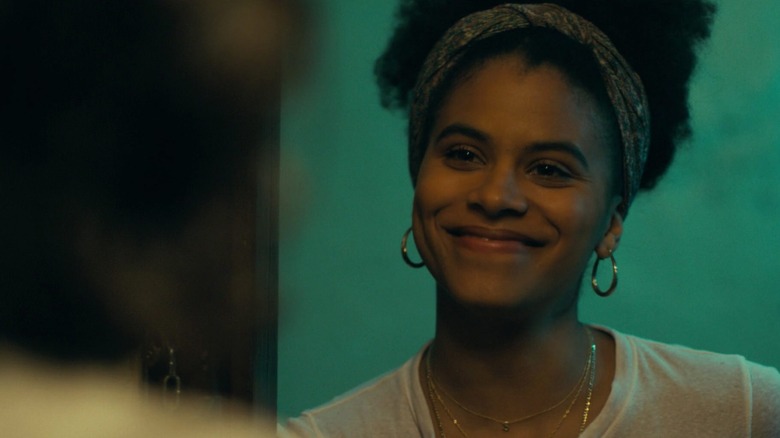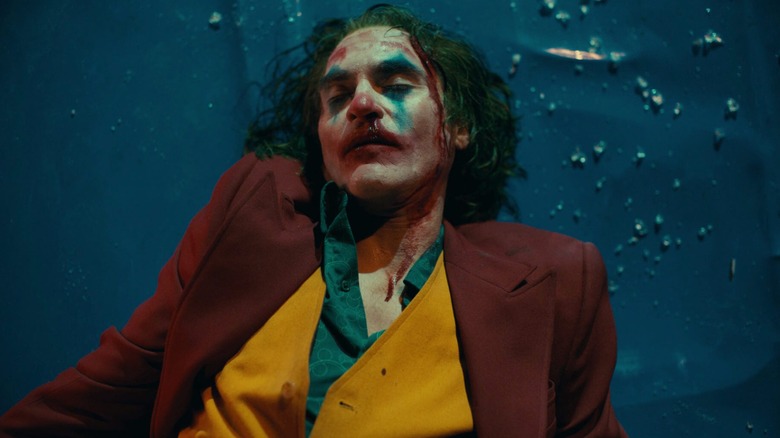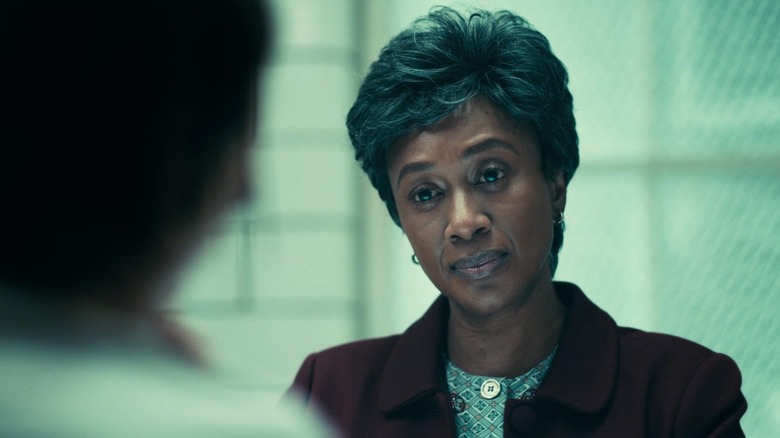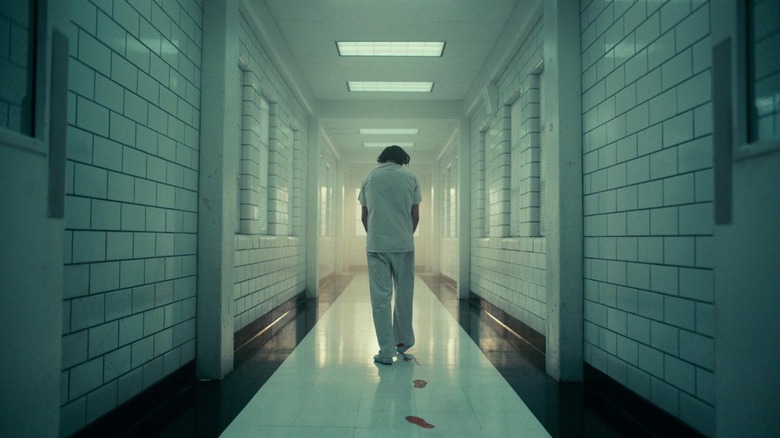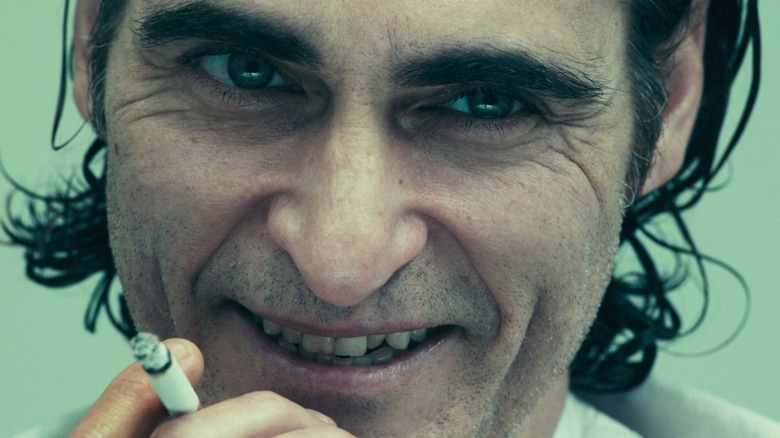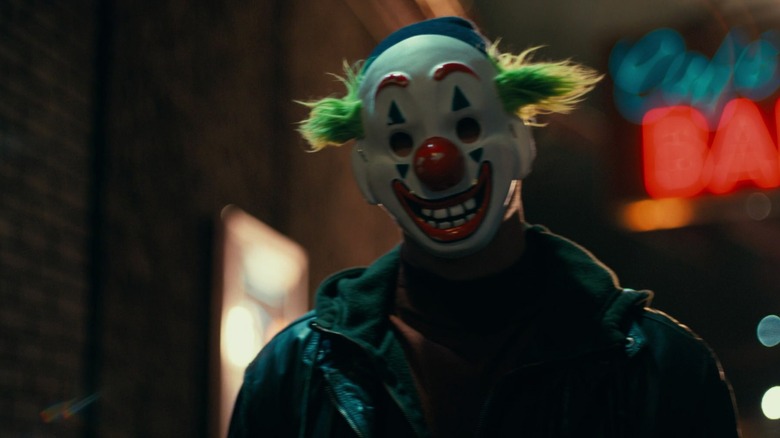Joker Ending Explained: Arthur's Final Joke Kills
In 2008's "The Dark Knight," Heath Ledger's Joker preached that the people in charge of Gotham City shouldn't be afraid to "introduce a little anarchy" into their world. The citizens didn't that time around, but it's a sentiment that Joaquin Phoenix's sad-sack villain seemed to take to heart for the next iteration of the character, in Todd Phillips' polarizing 2019 film "Joker." Phoenix's take on the Clown Prince of Crime is a far cry from anything DC fans had seen on screen before, as Phillips made the movie by pulling as much from the works of Paul Schrader and Martin Scorsese as he did from the superhero comics oeuvre.
With an R-rating, a Venice Film Festival release, and the promise of a standalone story, "Joker" arrived on the scene with a veneer of unusual prestige for a comic book movie. It also immediately divided fans and audiences, thanks in part to its seemingly bottomless nihilistic depths and, according to some, the potential to incite real violence. By the film's end, neglected, mentally ill loner Arthur Fleck had certainly introduced anarchy to Gotham City, and the movie bows out on an ambiguous, ironic, and decidedly violent note. But with a second "Joker" film in the works, it's worth digging into the ending of the first film; now that this isn't a standalone story anymore, what do Arthur Fleck's crimes mean for him — and for the future of Gotham?
What you need to remember about the plot of Joker
"Joker" takes place in Gotham City in an exaggerated version of the '80s, one in which crime is rampant, the economy is down, and billionaires like Thomas Wayne rule the world while a guy like Arthur — who is mentally unstable and has a disability that makes him burst into random fits of laughter — feels neglected by society. (Read our review here.) The film spends a lot of its screen time showing us just how downtrodden Arthur is. He works with social services but receives little lasting help for any of his issues. He also gets fired from his job as a clown after being caught with a gun that he carried for self-defense and is beaten viciously by businessmen working for Thomas Wayne.
Arthur's life is miserable as hell, but it takes a turn when he starts to stop playing by society's rules and starts to get violent. When he shoots the businessmen, he inspires a series of clown-faced criminal imitators, and the city breaks into anarchy after cops shoot a protester. With his newfound creepy confidence, Arthur terrorizes a young Bruce Wayne, freaks out a neighbor (Zazie Beetz) he imagined having a relationship with, and kills both a coworker and his ill mother (who at one point claimed Thomas Wayne was his real father).
The climax of "Joker" takes place on a late show where the host, Murray (Robert De Niro), had previously mocked Arthur's failed attempt to do standup. After he tells Murray to call him Joker — the name he'd called Arthur after seeing his viral standup clip — Phoenix's character stutters through some jokes during the telecast. His mood shifts partway through the interview, though, and he ends up confessing to murder and killing Murray live on the air.
What happened at the end of Joker?
When Arthur kills Murray, he makes his motivations clear. "What do you get when you cross a mentally ill loner with a society that abandons him and treats him like trash?" he asks. He answers the bad joke himself: "You get what you f**ing deserve." As viewers hear the studio audience clamor to run away, Arthur dances around on set before grabbing the camera for a goodnight message.
After this, we see Arthur in the back of a police car riding through a city filled with rioters. Gotham is on fire while people dance in the streets. When the driver of the car says it's all Arthur's fault, he responds with pride: "I know, isn't it beautiful?" Soon, rioters crash into the vehicle and Arthur ends up free. He once again dances to a tune that's only in his head, smearing blood on his face in the shape of the classic Joker grin while audiences who presumably watched the show cheer him on. Elsewhere that night, a clown mask-wearing criminal brutally kills Bruce Wayne's parents in front of him.
The final scene shows Arthur clad in white in Arkham Asylum, talking to an uneasy-looking therapist (April Grace) in an empty room. He laughs while the camera flashes on a shot of orphaned Bruce Wayne, and when the therapist asks what's funny, he says, "You wouldn't understand." Then, in a meta moment, he sings the words to Sinatra's "That's Life" as we hear the song play. The next shot shows Arthur walking away down the building's hallway, leaving a trail of bloody footsteps. At the end of the hall, he does a little shoulder shimmy (always dancing, this guy), and the final seconds show him running back and forth in the hallway, pursued by orderlies.
One last murderous joke?
While the nihilistic, city-on-fire ending of "Joker" is pretty straightforward, its white room epilogue is more ambiguous. The clearest explanation for the blood Arthur tracks through the hallway is that he killed the therapist he was speaking with (his hands were free for a cigarette break, after all) and broke free. The shot of orderlies chasing him in the distance supports this read, and the open-ended conclusion would leave room for a sequel. Anyone who reads DC comics knows the Joker never stays locked up forever, and with a whole city cheering him on, he'd leave the institution more confident and murderous than ever.
Some fans have questioned the validity of this ending by claiming that Arthur only killed people who he thought "deserved" to die, but to try to ascribe such a clear moral pattern to a character like this doesn't seem helpful. He may have killed some of the Wayne workers in self-defense, but he also saw them as greedy bullies. He perceived his mother as giving him false hope for a better future after reading her letter about his parentage, and when he found out that was a lie, he couldn't live with her anymore. His coworker Randall (Glenn Fleshler) didn't save him from losing his job, and Murray made fun of him on TV.
Arthur is fueled by anger and self-pity as much as any warped sense of justice, so any number of things about the therapist could have set him off. Or, after considering the Wayne family's deaths, he might have decided he doesn't need a reason to kill, marking a full transformation into the chaos-fueled villain we all know. When the therapist asks if he wants to tell her the joke, the punchline might be more violent than she thinks.
Unreliable narrator, unreliable ending
There's also the possibility that some of the final scenes are imagined, hallucinated, or included for metaphorical effect. We know that Arthur is an unreliable narrator, even to himself, and there's an otherworldly nature to the final scene. In addition to his spontaneous musical moment, when Arthur walks down the hallway, his feet form perfect blood stains while the rest of him looks clean. "The End" title card on screen seconds later looks like that of a classic black-and-white movie, making the orderly chase feel like a slapstick homage. Plus, there's a cheery bright light at the end of the hall that's at odds with the film's overall darkness.
Arthur could be imagining a scenario where he gets the upper hand, playing a "joke" on Arkham and Gotham by committing to the bit that is his homicidal streak. The blood on his feet may be a symbol of Arthur's disregard for human life. Instead of the typical symbol of blood on someone's hands, where it can't be looked away from, it's underfoot, and he doesn't bother to look back.
The imagined scene theory raises the question: was the scene before it imagined, too? The detail that the people of Gotham cheer Arthur on seems like a strong narrative choice from Phillips and co-screenwriter Scott Silver, supporting their central character's ideas about how the broken world works. Yet it doesn't really make sense in context when we know people were terrified of him on Murray's show just moments ago. It's possible that Arthur's star-making performance atop the cop car was all in his head, as it feels like an ending he'd write for himself. According to Vulture, some fans posit that even more of the movie might be imagined, though those theories don't make a ton of sense.
What has the cast and crew of Joker said about the ending?
In an interview with CinemaBlend's Reel Blend podcast, Phoenix responded to a theory that Arthur never actually left Arkham Asylum when he entered it earlier in the film to steal his mother's file, meaning much of the film's second half would be the character's own demented fantasy. "I don't know what part of this is real," Phoenix admitted. "I don't know where reality ends and his fantasies begin."
This idea fits in with the film's dream-like presentation. Gotham starts out feeling like a heightened nightmare version of our own world and ends with the worst-case scenario version of what might happen if someone like Arthur slips through the cracks of the systems meant to help him. He can't fix his life, he thinks, but he can create a new one, and whether or not that new one is real might just be beside the point.
"For me, the joy of this script and people's reaction is how everybody has a different kind of feeling about it, and different ideas of what it could mean, and what's real and what isn't," Phoenix continued. While Phoenix admits he has his own take on what parts of Arthur's story are real, he sees the audience's participation and ability to decide what they think happened as one of its great strengths. Writer-director Phillips expressed similar sentiments in an interview with Entertainment Tonight, noting that one day he'll talk about which theories align with his own, but for now he's happy to see people explore the film's ambiguity. "I like that you can view this movie in many different ways," he told the outlet, noting that "You don't want to hamper what other people's experiences [are with the film.]"
What the end of Joker could mean for the franchise
Of course, these interviews may have taken place before Phillips signed on for a follow-up film, which is due in 2024 and will be called "Joker: Folie à Deux." Lady Gaga is set to star opposite Phoenix in the sequel, while Beetz will reprise her role as the woman he had an imagined relationship with, Sophie. The sequel will likely provide more clarity on the original film's ending, as Arthur either will or won't be trapped in Arkham Asylum the next time we see him.
If some portion of the film's "King of Comedy"-inspired third act is entirely unreal, that means Arthur may actually still be a nobody — or a hated criminal — rather than the face of Gotham's anarchic new regime. If it was all real, Arthur might be in Arkham where we left him, unless he escaped after killing his therapist. While "Joker" had very little loyalty to comic book canon, it's also worth noting that most versions of this story have historically involved Joker meeting Harley Quinn – the character Gaga is set to play – when he's institutionalized and she's working as a psychiatrist. Hey, maybe the new movie will have a twisted meet-cute in which she takes over for his last mental health care provider, aware that she has a pretty high chance of getting killed by her patient.
There's also the Batman of it all to contend with. Will the new sequel show an older Bruce Wayne who hates the Joker for causing the chaos that killed his family? Did that death scene really even happen? Only time will tell, but it's worth noting that Phillips actually reportedly considered a totally different Wayne family ending.
Joker's alternate ending
While you won't find a "Joker" alternate ending available to view online, rumors about one persist thanks to a tidbit shared by filmmaker Kevin Smith on his "Fatman Beyond" podcast (via CinemaBlend). In a discussion of the film, Smith explains that he was told about a proposed original ending for the movie in which Arthur himself is revealed to be the Wayne family's killer, and Bruce Wayne ends up in his crosshairs.
"Originally, the ending in the hospital was different," Smith shared. "He's in the hospital and he laughs, chuckles, and he says, 'I was just thinkin' of something funny.'" In the theatrical version of the film, a quick flash to the aftermath of the Wayne killing shows that he was thinking about the deaths of Bruce's parents, but there's no implication that he was the man in the clown mask. According to Smith, though, "What was supposed to happen was you flashed back to the death of Thomas and Martha Wayne and it was him killing Thomas and Martha Wayne."
What's more, the version of the end Smith describes sounds like it would have one final, black-hearted punchline. "And the boy was screaming and crying," Smith described, "and [Arthur] turned to walk away and he turned back, shrugged, shot the kid. Credits." Honestly, I admire the ballsiness of an ending that would hinge on a dark joke about how little the movie cares about the story of Batman, but given how poorly a similar joke about The Illuminati went over in "Doctor Strange in the Multiverse of Madness," it might be a good thing if the movie pulled back from this ending. Instead, we got ambiguity. As Sinatra would say, "That's life!"
